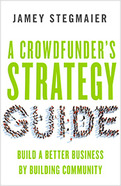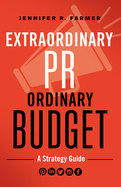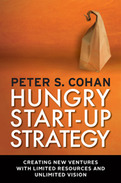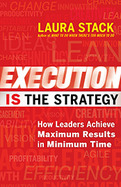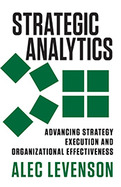Jamey Stegmaier knows crowdfunding. He's a veteran of seven successful Kickstarter campaigns (and counting) that have raised over $3.2 million, and he's the proprietor of the widely read Kickstarter Lessons blog. In this book he offers a comprehensive guide to crowdfunding, demonstrating that it can be a powerful way for entrepreneurs to grow their businesses by building community and putting their customers first.
This book includes over forty stories of inspiring successes and sobering disasters. Stegmaier uses these examples to demonstrate how to (and how not to) prepare for a campaign, grow a fan base, structure a pitch, find new backers, and execute many other crucially important “nuts and bolts” elements of a successful crowdfunding project.
But Stegmaier emphasizes that the benefits of crowdfunding are much more about the “crowd” than the “funding.” He shows that if you treat your backers as people, not pocketbooks—communicate regularly and transparently with them, ask their opinions, attend to their needs—they'll become advocates as well as funders, exponentially increasing your project's chances of succeeding.
Public relations is a make-or-break factor for all organizations, especially those that are small or mission driven. While it can be tempting to think that PR is a luxury only larger organizations can afford, PR expert Jennifer R. Farmer shows how her CCRR framework—being credible, creative, responsive, and relentless—is the silver bullet for even cash-strapped organizations.
Farmer emphasizes that effective public relations is in fact an essential component of organizational development—people need to know about you for your organization to have maximum impact. Her CCRR framework leverages tools everyone has access to, from social media to brand transparency, and requires attentiveness more than money. Farmer shows you that, no matter how modest your budget, you can build a cost-effective communications strategy that will help you break through the noise in an information-overloaded world.
Unshackle your authentic self from the expectations and stereotypes of American culture through the 6 pillars of living free as a Black woman.
Tamara Winfrey Harris harnesses her knowledge as a two-time author and storyteller of the Black femme experience and nationally known expert on the intersections of race and gender to deliver a sharp feminist analysis that is illustrated by real-life stories and examples plucked from popular culture and intimate Black woman-to-Black woman truth-telling.
This book is separated into two parts. First, the meaning of liberation is explored and Black women will be guided in creating sustaining practice to mature their well-being along the freedom journey.
In part two, readers are introduced to the 6 pillars of living free as a Black woman:
- Spot the distortions
- Know your truth
- Celebrate the real you
- Understand the cost of liberation
- Practice freedom
- SEE free Black women everywhere
Entrepreneurs are hungry. But it's not just because they're living on ramen and adrenaline while they pour their all into their business. Peter Cohan has found it's something deeper: a hunger to create the kind of world they want to work in.
- The first research-based book on business strategy for start-ups
- Based on Cohan's venture investment experience and on his interviews with over 150 start-up CEOs
- Offers specific approaches for six critical start-up decisions
Entrepreneurs are hungry. But it's not just because they're living on ramen and adrenaline while they pour their all into their business. Peter Cohan has found it's something deeper: a hunger to create the kind of world they want to work in. To leave a legacy, they build carefully with limited resources and maintain control of the venture's direction.
For years, students have told Cohan that the seminal business strategy guide, Michael Porter's Competitive Strategy, was too big-company focused. So Cohan -- who once worked with Porter-has written the first business strategy book to address start-ups' very different challenges.
Cohan focuses on six key start-up choices-setting goals, picking markets, raising capital, building teams, gaining market share, and adapting to change-explaining the unique rules start-ups must follow. For example, when setting goals, large corporations try to maximize their long-term return on equity, but resource-poor start-ups have to plan by setting a series of short-term goals-and how they do this will mean the difference between blazing a trail or flaming out. When entering a new market, well-fed companies can invest substantial time and capital before ever launching a product, but hungry start-ups must get an adequate prototype in front of customers fast, get feedback, and quickly develop a viable business model or they'll starve to death.
For each of these six areas, Cohan provides a decision-making approach and lively case studies of what actual entrepreneurs have done. He extracts hard-hitting lessons not only for start-ups but also for investors and even established companies. Hungry Start-up Strategy offers a full menu of vital information for anyone seeking to cook up a thriving business from scratch.
- The first research-based book on business strategy for start-ups
- Based on Cohan's venture investment experience and on his interviews with over 150 start-up CEOs
- Offers specific approaches for six critical start-up decisions
- Click here for the press release
Entrepreneurs are hungry. But it's not just because they're living on ramen and adrenaline while they pour their all into their business. Peter Cohan has found it's something deeper: a hunger to create the kind of world they want to work in. To leave a legacy, they build carefully with limited resources and maintain control of the venture's direction.
For years, students have told Cohan that the seminal business strategy guide, Michael Porter's Competitive Strategy, was too big-company focused. So Cohan -- who once worked with Porterhas written the first business strategy book to address start-ups' very different challenges.
Cohan focuses on six key start-up choicessetting goals, picking markets, raising capital, building teams, gaining market share, and adapting to changeexplaining the unique rules start-ups must follow. For example, when setting goals, large corporations try to maximize their long-term return on equity, but resource-poor start-ups have to plan by setting a series of short-term goalsand how they do this will mean the difference between blazing a trail or flaming out. When entering a new market, well-fed companies can invest substantial time and capital before ever launching a product, but hungry start-ups must get an adequate prototype in front of customers fast, get feedback, and quickly develop a viable business model or they'll starve to death.
For each of these six areas, Cohan provides a decision-making approach and lively case studies of what actual entrepreneurs have done. He extracts hard-hitting lessons not only for start-ups but also for investors and even established companies. Hungry Start-up Strategy offers a full menu of vital information for anyone seeking to cook up a thriving business from scratch.
Shows how strategy and tactics are part of the same overarching process, requiring greater flexibility and more rapid implementation than ever before.
- Shows how strategy and tactics are part of the same overarching process, requiring greater flexibility and more rapid implementation than ever before
- Reveals how to create agile and resilient organizations, where execution continually modifies and adjusts the strategy to fit current realities
- Includes the "Execution Quotient" leadership assessment and access to an online group reading guide and self-development resources
Once upon a time, executives would go to an off-site brainstorming session, come back with a multiyear strategic plan, and hand it off to their employees to dutifully execute. But in today's world of rapid, disruptive change, it's hard enough to come up with a five-month plan, let alone a five-year plan. As one executive interviewed by author Laura Stack put it, "You prepare a strategic plan and then put it on the shelf while the real world passes you by."
Nowadays, strategy can't be separate from execution-it has to emerge from execution. New technologies, sudden changes in global markets, and viral customer reactions to new products require quick, nimble responses-sometimes even a complete strategic 180. But if your organization isn't set up to be fast on its feet, you could easily go the way of Blockbuster or Borders.
Stack shows you how to make sure your organization is ready for on-the-spot strategic execution. Her LEAD formula explains how to Leverage the people and resources you need to create an agile organization, establish an Environment where your employees are confident and capable enough to take the initiative and make on-the-fly changes, ensure that your team is in Alignment with the organization's goals so they'll make the right strategic choices, and remove obstacles so they can Drive the organization forward quickly.
Of course, you'll still need to have a great strategy in place, but your goals must be subject to constant readjustment and revision. You have to work with your team to build effective business strategies in real time, not be bound by a plan that may be out of date as soon as it rolls off the printer. Execution really is the strategy that will propel your organization forward, and Laura Stack can help you build an organization ready to meet the challenge of constant change.
2015
The problem, Levenson says, is that the business people who devise the strategies and the human resources people who get employees to implement them use completely different analytics. Business analytics can determine if operational priorities aren't being achieved but can't explain why. HR analytics reveal potentially helpful policy and process improvements but can't identify which would have the greatest strategic impact.
This book shows how to use an integrated approach to bring these two pieces together. Levenson presents a thorough and realistic treatment of the reasons for and challenges of taking an integrated approach. He provides details on the different parts of both enterprise and human capital analytics that have to be conducted for integration to be successful and includes specific questions to ask, along with examples of applying integrated analytics to address particular organizational challenges.
Effective analytics is a team sport. Levenson's approach allows you to get the deepest insights by bringing people together from both the business and HR perspectives to assess what's going on and determine the right solution.


